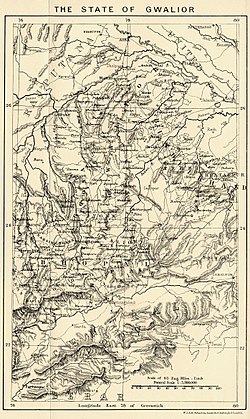
Back গোয়ালিয়র রাজ্য Bengali/Bangla Gwalior Catalan Gwalior (Staat) German État de Gwalior French ग्वालियर रियासत Hindi Negara Gwalior ID Gwalior (stato) Italian ग्वाल्हेर संस्थान Marathi ग्वालियर राज्य Nepali ਗਵਾਲੀਅਰ ਰਿਆਸਤ Punjabi
State of Gwalior | |||||||||||||
|---|---|---|---|---|---|---|---|---|---|---|---|---|---|
| 1731–1948 | |||||||||||||
 Gwalior State within the Maratha Confederacy in 1761 (Yellow) | |||||||||||||
 Map of Gwalior State in 1903 | |||||||||||||
| Status | Kingdom within the Maratha Confederacy (1731–1818) Protectorate of the East India Company (1818–1857) Princely State of the India (1857–1947) State of the Dominion of India (1947–1948) | ||||||||||||
| Capital | |||||||||||||
| Common languages | |||||||||||||
| Government | Monarchy | ||||||||||||
| Maharaja | |||||||||||||
• 1731–1745 | Ranoji Scindia (first) | ||||||||||||
• 1925–1948 | Jiwajirao Scindia (last) | ||||||||||||
| History | |||||||||||||
• Established | 1731 | ||||||||||||
| 15 June 1948 | |||||||||||||
| |||||||||||||
| Today part of | India ∟ Madhya Pradesh | ||||||||||||
The Gwalior State was a state within the Maratha Confederacy located in Central India. It was ruled by the House of Scindia (anglicized from Sendrak), a Hindu Maratha dynasty. Following the dissolution of the Confederacy, it became part of the Central India Agency of the Indian Empire under British protection.
The state was entitled to a 21-gun salute when it became a princely state of the India.[1] It took its (later) name from the old town of Gwalior, which, although not its first capital, was an important place because of its strategic location and the strength of its fort; it became later its capital, after Daulat Rao Sindhia built its palace in the village of Lashkar, near the fort. The state was founded in the early 18th century by Ranoji Sindhia, as part of the Maratha Confederacy. The administration of Ujjain was assigned by Peshwa Bajirao I to his faithful commander Ranoji Shinde and his Sarsenapati was Yasaji Rambhaji (Rege). The Mahakaaleshwara temple situated in ujjain was reconstructed during the administration of Shrimant Ranojirao Scindia in ujjain.[2][full citation needed]
Under Mahadji Sindhia (1761–1794) Gwalior State became a leading power in Central India, and dominated the affairs of the confederacy. The Anglo-Maratha Wars brought Gwalior State under British suzerainty, so that it became a princely state of the Indian Empire. Gwalior was the largest state in the Central India Agency, under the political supervision of a Resident at Gwalior. In 1936, the Gwalior residency was separated from the Central India Agency, and made answerable directly to the Governor-General of India. After Indian Independence in 1947, the Scindia rulers acceded to the new Union of India, and Gwalior state was absorbed into the new Indian state of Madhya Bharat.[3]

- ^ "Gwalior – Princely State (21 gun salute)". Archived from the original on 8 August 2018. Retrieved 11 August 2014.
- ^ Website of Shri Mahakaleshwar temple, Ujjain
- ^ Boland-Crewe, Tara; Lea, David (2004). The Territories and States of India. Psychology Press. ISBN 9780203402900.

